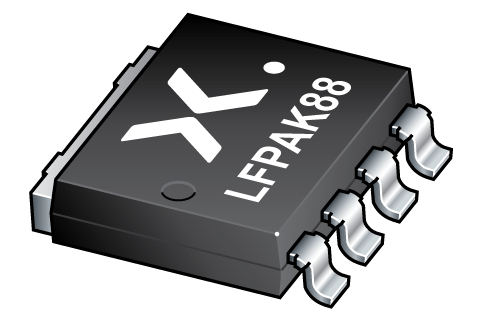Orderable parts
| Type number | Orderable part number | Ordering code (12NC) | Package | Buy from distributors |
|---|---|---|---|---|
| BUK7S1R2-80M | BUK7S1R2-80MJ | 934667069118 | SOT1235 | Order product |
Discover Nexperia’s extensive portfolio of diodes, bipolar transistors, ESD protection devices, MOSFETs, GaN FETs, IGBTs, and analog & logic ICs. Our components power virtually every electronic design worldwide - from automotive and industrial to mobile and consumer applications.
Our products find applications across various industries, from automotive and industrial to power, computing, consumer, mobile, and wearables. With a commitment to innovation and sustainability, our components set benchmarks in efficiency, empowering our global customer base to develop energy-efficient and cutting-edge solutions.

Register once, drag and drop ECAD models into your CAD tool and speed up your design.
Click here for more informationN-channel 80 V, 1.2 mOhm, Standard level MOSFET in LFPAK88
Automotive qualified N-channel MOSFET using the latest Trench 14 low ohmic split-gate technology, for ultra-low RDSon capability, housed in a LFPAK88 package. This product has been fully designed and qualified to meet AEC-Q101 requirements delivering high performance and endurance.
Fully automotive qualified to AEC-Q101:
175 °C rating suitable for thermally demanding environments
Trench 14 split-gate technology:
Reduced cell pitch enables enhanced power density and efficiency with lower RDSon in same footprint
Fast and efficient switching with optimal damping and low spiking
LFPAK Gull Wing leads:
High Board Level Reliability absorbing mechanical stress during thermal cycling, unlike traditional QFN packages
Visual (AOI) soldering inspection, no need for expensive x-ray equipment
Easy solder wetting for good mechanical solder joints
LFPAK copper clip technology:
Improved reliability, with reduced Rth, RDSon and package inductance
Increases maximum current capability and improved current spreading
12 V, 24 V and 48 V automotive systems
Motor, lighting and solenoid control
Ultra high-performance power switching
| Type number | Package version | Package name | Product status | Channel type | Nr of transistors | VDS [max] (V) | RDSon [max] @ VGS = 10 V (mΩ) | Tj [max] (°C) | ID [max] (A) | QGD [typ] (nC) | QG(tot) [typ] @ VGS = 10 V (nC) | Ptot [max] (W) | Qr [typ] (nC) | VGSth [typ] (V) | Automotive qualified | Ciss [typ] (pF) | Coss [typ] (pF) | Release date |
|---|---|---|---|---|---|---|---|---|---|---|---|---|---|---|---|---|---|---|
| BUK7S1R2-80M | SOT1235 | LFPAK88 | Development | N | 1 | 80 | 1.2 | 175 | 335 | 29 | 164 | 341 | 68 | 3 | Y | 11891 | 2645 | 2023-10-10 |
| Type number | Orderable part number, (Ordering code (12NC)) | Status | Marking | Package | Package information | Reflow-/Wave soldering | Packing |
|---|---|---|---|---|---|---|---|
| BUK7S1R2-80M | BUK7S1R2-80MJ (934667069118) |
Development | 7S1R280M |

LFPAK88 (SOT1235) |
SOT1235 |
REFLOW_BG-BD-1
|
SOT1235_118 |
| Type number | Orderable part number | Chemical content | RoHS | RHF-indicator |
|---|---|---|---|---|
| BUK7S1R2-80M | BUK7S1R2-80MJ | BUK7S1R2-80M |
|
|
| File name | Title | Type | Date |
|---|---|---|---|
| BUK7S1R2-80M | N-channel 80 V, 1.2 mOhm, Standard level MOSFET in LFPAK88 | Data sheet | 2024-02-13 |
| AN50020 | MOSFETs in Power Switch applications | Application note | 2024-05-27 |
| SOT1235 | 3D model for products with SOT1235 package | Design support | 2020-01-22 |
| Nexperia_package_poster | Nexperia package poster | Leaflet | 2020-05-15 |
| LFPAK88_sot1235_mk | plastic, single-ended surface-mounted package (LFPAK88); 4 leads; 2 mm pitch; 8 mm x 8 mm x 1.6 mm body | Marcom graphics | 2019-04-10 |
| BUK7S1R2-80M_LTspice_V1 | BUK7S1R2-80M Precision ElectroThermal (PET) LTspice model | PET SPICE model | 2024-07-18 |
| SOT1235 | plastic, single-ended surface-mounted package (LFPAK88); 4 leads; 2 mm pitch; 8 mm x 8 mm x 1.6 mm body | Package information | 2022-05-30 |
| SOT1235_118 | LFPAK88; Reel pack, SMD, 13"; Q1/T1 standard product orientation; Orderable part number ending ,118 or Z; Ordering code (12NC) ending 118 | Packing information | 2020-04-21 |
| REFLOW_BG-BD-1 | Reflow soldering profile | Reflow soldering | 2021-04-06 |
If you are in need of design/technical support, let us know and fill in the answer form we'll get back to you shortly.
| File name | Title | Type | Date |
|---|---|---|---|
| BUK7S1R2-80M_LTspice_V1 | BUK7S1R2-80M Precision ElectroThermal (PET) LTspice model | PET SPICE model | 2024-07-18 |
| SOT1235 | 3D model for products with SOT1235 package | Design support | 2020-01-22 |
| Type number | Orderable part number | Ordering code (12NC) | Status | Packing | Packing Quantity | Buy online |
|---|
As a Nexperia customer you can order samples via our sales organization.
If you do not have a direct account with Nexperia our network of global and regional distributors is available and equipped to support you with Nexperia samples. Check out the list of official distributors.
The interactive datasheets are based on the Nexperia MOSFET precision electrothermal models. With our interactive datasheets you can simply specify your own conditions interactively. Start by changing the values of the conditions. You can do this by using the sliders in the condition fields. By dragging the sliders you will see how the MOSFET will perform at the new conditions set.